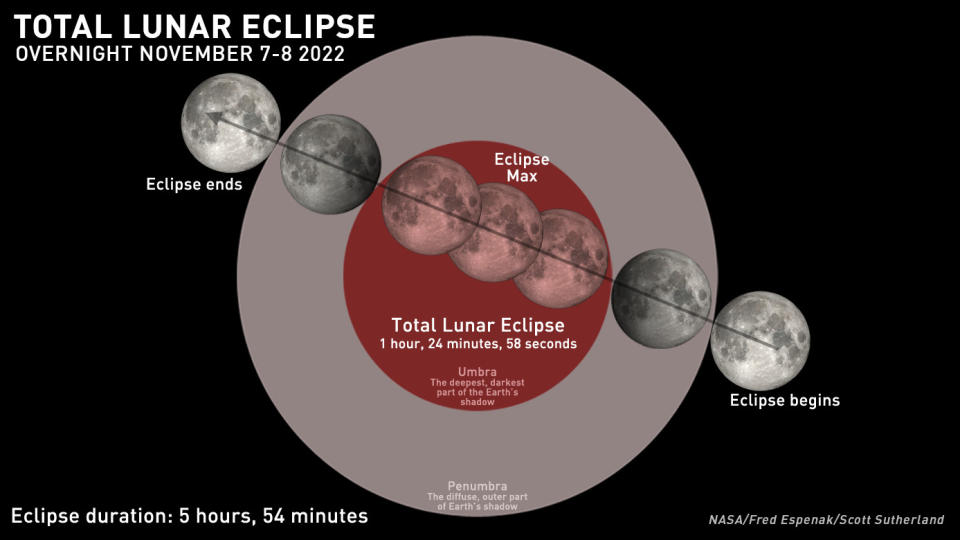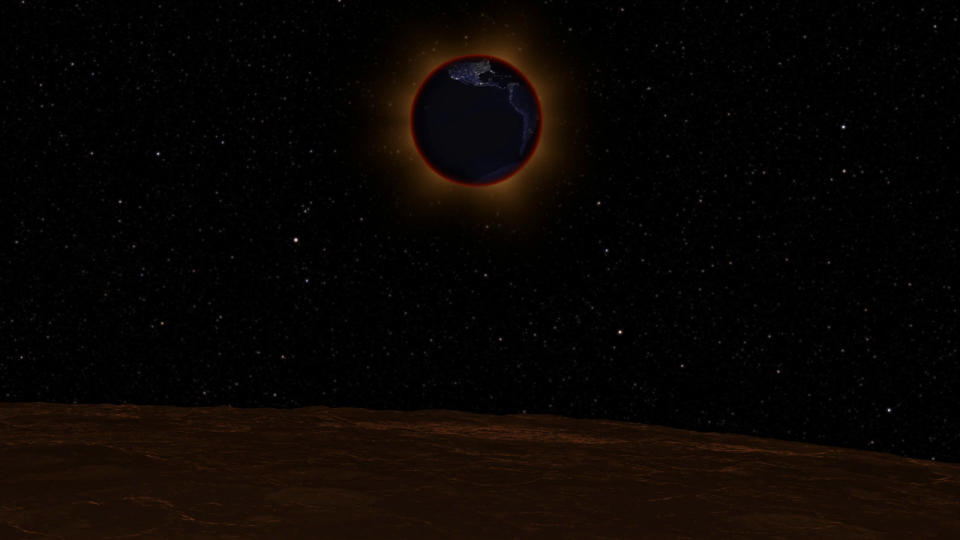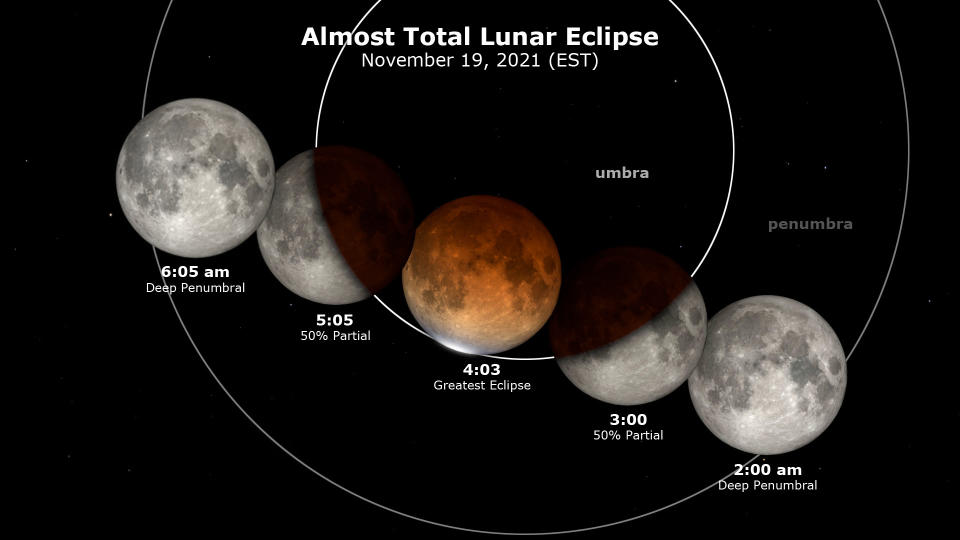Look up! A Total Lunar Eclipse will shine across Canada overnight tonight
You'll want to get up early or stay up late for tonight's Full Beaver Moon, as it puts on a fantastic show in the night sky!
Originally published on Wed., Nov. 2, 2022, this article has been updated.
On the night of November 7-8, the Sun, Earth, and the Full Moon will line up perfectly to produce a total lunar eclipse. Weather permitting, nearly all of Canada will be able to see the Moon turn blood red during the event.

This image shows an idealized telescopic view of the Full Moon during the November 8, 2022, Total Lunar Eclipse. Credit: NASA's Scientific Visualization Studio
However, depending on where you are watching from, the timing of the eclipse may not be the most favourable.
The event will favour the western half of the country. There, viewers with clear skies can watch the entire eclipse from beginning to end. However, even so, this astronomical alignment takes place throughout the hours after midnight. So, anyone who wants to see it for themselves will need to stay up late.
The farther east you are during the event, the earlier the eclipse will end due to the Moon setting below the horizon.
Viewed from eastern Ontario, southern Ontario, and Quebec, the Moon will dip below the horizon during the 'total' phase of the eclipse. For most of Atlantic Canada, the Moon will set just after the total eclipse begins. Newfoundland is the only part of the country that misses out on the total eclipse. They are far enough east that the Moon will set before it turns completely red.

Will we see it?
Besides the timing of the event, the weather is critical in determining who will see the eclipse and who won't.
As of the forecast from Monday morning, there will be a lot of clouds in the sky over western Canada during the event.

However, the eastern half of Ontario, southwestern Quebec, most of New Brunswick, Prince Edward Island, Nova Scotia, and eastern Newfoundland, will have mainly clear skies. Thus, they should be able to enjoy the portion of the eclipse that will be visible from those locations.
What will we see?
The eclipse begins just after 3 a.m. EST and lasts for close to six hours. Also, this is an event that we all must watch simultaneously across the country. Check the convenient table at the end of this section to help with the timing, based on your local time zone.
For roughly the first hour of the eclipse, the Moon will pass through the penumbra, the diffuse outer band of Earth's shadow. The effect of this is very subtle at first. Keen-eyed observers will see a slight dimming of the Moon, but this phase of the eclipse tends to be challenging to notice.
During the second hour of the eclipse, the Moon begins its transition from the penumbra into the umbra. If you want to watch during the best part of the event, this is the time to go outside and look up. Slowly, a dark shadow will creep across the Moon, from left to right. Due to the contrast between the darker part of the Moon in the umbra and the brighter part in the penumbra, the umbra's redness may be difficult to spot at first. However, as the Moon progressively darkens, this red colour will become more apparent. During this part of the eclipse, the Moon will set for those living in Newfoundland.

The hour and 25 minutes that follows is the part you won't want to miss — the peak of the total lunar eclipse!
This is when the Moon turns a dusky red colour, as it becomes fully immersed in the umbra. Viewers in Nova Scotia, Prince Edward Island and New Brunswick will see the Moon set shortly after this part of the eclipse begins. For those in Quebec and the eastern half of Ontario, the Moon will set before this part of the eclipse ends.
Once the peak of the eclipse is over, the Moon takes another hour or so to pass from the umbra back into the penumbra. During this phase of the eclipse, the Moon will dip below the horizon for viewers in western Ontario and most of Manitoba.
After that, it will take just over an hour for the Moon to completely exit Earth's shadow, thus ending the eclipse. Anyone watching from west of Manitoba can watch the entire event right up to the end.
The table below provides a guide for the timing of the eclipse, broken down by time zones across Canada.

The timing of the Total Lunar Eclipse for Canadian time zones. Data from NASA/Fred Espenak. Background image courtesy NASA's Scientific Visualization Studio
What's going on here?
So, what causes lunar eclipses?
As our spherical Earth is illuminated on one side by the immense star at the centre of our solar system, the planet casts two shadows into space behind it. Observed from space, the shadows form two long 'V' shapes, a diffuse one that gets wider (the penumbra) and a darker one that narrows to a point (the umbra).

This graphic shows the two parts of Earth's shadow. The distances and sizes in the image are exaggerated for illustration purposes. Credit: NASA
Observed from Earth, the shadows form overlapping circles, with the penumbra on the outside and the dark umbra in the middle.
The Moon doesn't pass through Earth's shadow on every orbit, though. The Moon's path around Earth is tilted, just enough that most Full Moons miss the shadow, passing either above or below it. However, once every five or six months, the Sun, Earth and Full Moon line up just right so the Moon passes through at least part of Earth's shadow.
You may ask: why does a total lunar eclipse turn the Moon red? For that, we have Earth's atmosphere to thank.
As sunlight filters through the atmosphere, it becomes scattered. The blue goes first, and then each successive colour of the visible spectrum. Only red light exits back into the darkness of space, which is then focused directly into the umbra by the curvature of the Earth. Effectively, a total lunar eclipse shows off all of Earth's sunrises and sunsets at exactly the same time.

This artist's impression shows what a total lunar eclipse looks like from the Moon, as all of Earth's sunrises and sunsets shine onto its surface. Credit: NASA
If it wasn't for the atmosphere, the inner part of Earth's shadow would be pitch black, and the Moon would appear to vanish during a total lunar eclipse. This actually happened, once, over 900 years ago.
Read more: How the Full Moon briefly vanished, nearly a thousand years ago
Why so long until the next one?
So, once this total lunar eclipse ends, we won't see another one for over two years.
That's not to say that there won't be ANY lunar eclipses between now and then. In fact, there will be four, with two directly visible from much of Canada.
It's just that, due to the angle of the Moon's orbit around the Earth, the Moon doesn't always pass directly through the umbra when we have a lunar eclipse.
Sometimes the Moon misses the umbra completely, only crossing through the penumbra (thus, it's a 'penumbral' eclipse). Other times we see a partial eclipse, where only part of the Moon passes through the umbra. Also, the different types of lunar eclipses tend to cluster. These days, we typically see a repeating pattern of 2 to 4 total eclipses in a row, followed by a string of 4 to 7 eclipses that can be all partial, all penumbral, or a mix of the two, and then another batch of total eclipses.

This infographic shows the three types of lunar eclipses. Credit: NASA SVS/Scott Sutherland
A seemingly rare exception to this pattern occurred in 2021. Following a partial eclipse in mid-2019 and four penumbral eclipses in 2020, there was a total lunar eclipse in May 2021 and another partial eclipse in November 2021. Then we were back to two total eclipses in 2022.
However, the November 19, 2021, partial lunar eclipse only missed being a total eclipse by an astronomical hair's breadth. Just a tiny sliver of the Moon remained outside the umbra during the event. This made it an 'almost' total eclipse and the longest partial eclipse seen in close to 600 years!

The path of the Moon during the "almost" total lunar eclipse of November 2019 is shown here. A very thin section of the Moon near its south pole did not pass through the umbra, making this a partial lunar eclipse. Credit: NASA's Scientific Visualization Studio
In 2023 and 2024, there are four lunar eclipses — one penumbral and one partial each year. The two 2024 eclipses will be well-timed to be visible from Canada, but neither of them will be easy to spot. Penumbral eclipses are always a challenge to notice since the penumbra only causes a slight dimming of the light reflected by the Moon. Even for the September 18, 2024, partial eclipse, just the Moon's north polar region will darken as it passes through the umbra.
For the next total lunar eclipse, mark the date — March 14, 2025 — on your calendars. Weather permitting, the event will be visible from right across Canada.
(Thumbnail image courtesy NASA's Scientific Visualization Studio)

